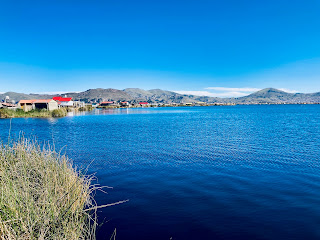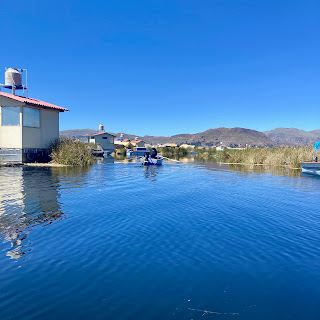Floating reed island of the Uro-Aymara on Lake Titicaca
Floating reed island of the Uro-Aymara on Lake Titicaca
At 12,500 feet, Lake Titicaca is the highest navigable lake in the world, the strong sun prevents it from freezing even in winter, covering 3210 sq miles and bordered by Peru to the North and Bolivia to the South.
Lake Titicaca is the home to the Uro-Aymara Indians, consisting of indigenous Uru-Chipaya, Uru-Murato, and Uru-Iruito tribes, famous for living for close to 4000 years on reed islands made from ubiquitous totora reed (Schoenoplectus californicus ssp. tatora), a giant bulrush sedge known as chullu in the local Uro language.
This is the same sort of bulrush used by the natives of Easter Island to build their sea worth boats, and what inspired Thor Heyerdahl (1914-2002), the Norwegian explorer and ethnographer, to work with Uros Indians in constructing large expedition reed boat Kon-Tiki expedition in 1947, in which he sailed 8,000 km (5,000 miles) across the Pacific Ocean from South America to the Tuamotu Islands.
 |
| New reed island under construction |
Uros-Amyara Indians traditionally lay down a 4 foot thick bed of totora reeds on root-bound clay clods to create floating islands. These islands are carefully anchored on all sides using long eucalyptus poles and moored to each other using guy ropes spun out of alpaca wool. It takes two to four years to make a new island, once the community council approves its construction. Dwelling roofs have tarp on which totora reed are layered to withstand torrential rains from December to March. Totora reed are constantly replenished every 2 weeks to account for wear and tear to the foundation. Most islands keep a cat to prevent rodents wreaking havoc on the island. With proper maintenance an island can last from 20 to 30 years before it is reclaimed by the lake.
Tourists can stay on one of these islands - with solar panels used to provide LED lighting and hot water. Eco-toilets also have been installed to keep the pristine waters safe from pollution. You also get to savour the same diet as the locals, consisting of fish - Trout (introduced from Canada in 1940) and King fish (introduced from Argentina) along with catfish and two native fish called ispi and carachi, supplemented of course with corn, quinoa, potatoes and tropical fruits. Domesticated birds such as the Ibis are raised to lay eggs and for meat. Some families even graze cattle on natural islands on Lake Titicaca or on the mainland.
Fresh cut reeds are expertly harvested by using a sharp sickle tied at an angle to a stout pole - one quick cutting movement under the crystal clear water and a handful of reeds are loaded onto the boat. These are brought on shore are stored like teepees to dry in the sun for two weeks before it is suitable for use to build reed balsa (boats), homes or islands. Two men take a month to build a reed boat that lasts two years. Eco-tourism remains the #1 source of revenue in the area.
These two reed boats lashed together are painted with UV protective garish yellow paint and propelled by an outboard motor. This is purely for the entertainment of tourists and has puma heads at the prow and a viewing balcony with unrestricted 360 degree vision. The boatsman are skilled at avoiding anchor lines marked with buoys.
Check out the short video of our host Juan harvesting totora for us to eat raw - very fibrous, not much taste but an important staple to the local diet. Totora also called chullu in the Uro language, is used as a food source. it is rich in calcium and iodine and is useful in preventing goitre.
We enjoyed the view from the dining room overlooking the lake … we ate all our meals here. Our hosts accommodated requests for vegetarian fare. Their son studied in a local culinary school. No frills lunch (trout, potato, yam, corn etc) and dessert (mango and banana slices drizzled with chocolate)
Clay vessels used to cook on mud stove placed on a stone slab and fuelled with dried totora reeds. This is how locals cook their food of corn, quinoa, potato, yam, vegetables, eggs etc. Nothing gets wasted, the totora ashes of the fire are used as an antiseptic
Our stay on the Uros-Aymara reed islands on Lake Titicaca was a once-in-a-lifetime experience and I'll highly recommend it to anyone adventurous enough to think out of the hotel room experience.
Pro travel tips:
1. How to get there: You can either come to Puno from Cusco or Arequipa by road - there are a couple of bus and train options available. Or alternatively you can fly from Lima to Inca Manco Cápac International Airport in Juliaca, which is about 45 minutes away from the Uros Islands
2. The best time to visit: is from April to November when it does not rain.
3. Due to the unrelenting sun and lack of shade, be careful of the UV rays. Bring along suntan lotion and SFP rated sun protective wear.
4. The reed islands truly float on the water so expect to feel some bobbing. The foundation is also made of reeds and feels a bit unstable at first but you'll soon get used to it.
5. Nights can get quite chilly - there is no central heating but the hosts provide generous amounts of duvets. Bring along thermal clothes to keep warm.
6. The bathrooms are very functional - nothing fancy. Really. The water is heated using solar panels so don't expect hot water 24x7.
7. The limited menu is exactly what the locals eat so be happy with what is available. Veggie options are even more limited.
8. The perils of city life are left far behind - no traffic jams, no Cable TV or Internet ... yup there are virtually no distractions which makes this the perfect place to curl up on one of deck chairs with a good read or simply let your senses drink in the ambience as your thoughts take you to a blissful place.












Comments
Post a Comment
Please keep conversations courteous and on-topic. Kindly don’t engage in trolling, flame-baiting, name-calling, insulting, stereotyping or gratuitous attacks. Thank you for being a good citizen.